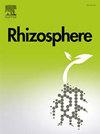硼中毒下拟南芥BOR转运体及其调控
IF 3.5
3区 生物学
Q1 PLANT SCIENCES
引用次数: 0
摘要
在拟南芥中,硼转运蛋白家族(AtBOR1-AtBOR7)介导硼外排、长距离转运和应激反应;然而,这些转运体之间的功能分化和调控机制仍然知之甚少。本研究通过综合结构、系统发育、基因表达和蛋白质相互作用分析,全面表征了AtBor基因家族。系统发育分析将7种AtBOR蛋白划分为3个不同的分支,表明进化多样化。在不同硼浓度和非生物胁迫条件下的表达谱显示,AtBOR1、AtBOR2和AtBOR3在组织中有组成性或中度表达,表明其在维持基础硼稳态中具有保守功能。相反,AtBOR4-AtBOR7表现出低表达或胁迫响应型表达模式,其中AtBOR3在低温胁迫下的诱导作用显著,表明其在非生物胁迫适应过程中可能参与硼的再分配。亚细胞定位分析预测了大多数AtBOR转运蛋白的主要质膜靶向性,而蛋白质相互作用研究涉及了囊泡运输、应激信号和解毒途径中的几个成员。这项研究首次系统表征了硼中毒下所有7个AtBOR基因,为其功能专门化和调控动态提供了新的见解。本研究结果显著提高了我们对硼转运体多样性的认识,为未来开发提高微量元素利用效率和增强环境胁迫抵御能力的作物品种奠定了基础。本文章由计算机程序翻译,如有差异,请以英文原文为准。

Arabidopsis BOR transporters and their regulation under boron toxicity
In Arabidopsis thaliana, the BOR transporter family (AtBOR1–AtBOR7) mediates boron efflux, long-distance transport, and stress responses; however, the functional differentiation and regulatory mechanisms among these transporters remain poorly understood. This study comprehensively characterizes the AtBor gene family through integrated structural, phylogenetic, gene expression, and protein interaction analyses. Phylogenetic analysis divided the seven AtBOR proteins into three distinct clades, indicating evolutionary diversification. Expression profiling under varying boron concentrations and abiotic stress conditions revealed constitutive or moderate expression of AtBOR1, AtBOR2, and AtBOR3 across tissues, suggesting conserved functions in maintaining basal boron homeostasis. Conversely, AtBOR4–AtBOR7 showed low or stress-responsive expression patterns, with notable induction of AtBOR3 in shoots under cold stress, indicating its potential role in boron redistribution during abiotic stress adaptation. Subcellular localization analyses predicted predominant plasma membrane targeting for most AtBOR transporters, while protein–protein interaction studies implicated several members in vesicle trafficking, stress signaling, and detoxification pathways. This study represents the first systematic characterization of all seven AtBOR genes under boron toxicity, providing novel insights into their functional specialization and regulatory dynamics. The results presented here significantly enhance our understanding of boron transporter diversity, laying the foundation for future development of crop varieties with improved micronutrient use efficiency and enhanced resilience to environmental stresses.
求助全文
通过发布文献求助,成功后即可免费获取论文全文。
去求助
来源期刊

Rhizosphere
Agricultural and Biological Sciences-Agronomy and Crop Science
CiteScore
5.70
自引率
8.10%
发文量
155
审稿时长
29 days
期刊介绍:
Rhizosphere aims to advance the frontier of our understanding of plant-soil interactions. Rhizosphere is a multidisciplinary journal that publishes research on the interactions between plant roots, soil organisms, nutrients, and water. Except carbon fixation by photosynthesis, plants obtain all other elements primarily from soil through roots.
We are beginning to understand how communications at the rhizosphere, with soil organisms and other plant species, affect root exudates and nutrient uptake. This rapidly evolving subject utilizes molecular biology and genomic tools, food web or community structure manipulations, high performance liquid chromatography, isotopic analysis, diverse spectroscopic analytics, tomography and other microscopy, complex statistical and modeling tools.
 求助内容:
求助内容: 应助结果提醒方式:
应助结果提醒方式:


